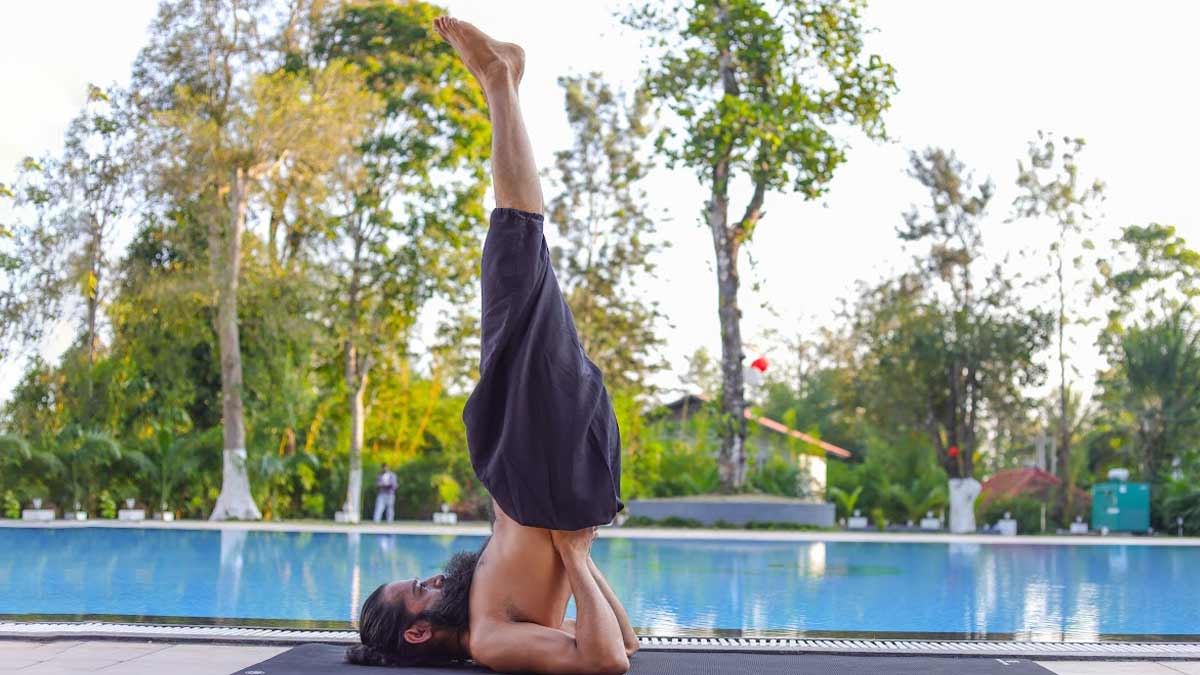
Sarvangasana, commonly known as the Shoulder Stand, is an inverted yoga posture that has been practiced for centuries in various yoga traditions. The name comes from the Sanskrit words "sarva" meaning "all" or "entire," and "anga" meaning "limb" or "body part," reflecting the pose's comprehensive benefits for the entire body. This pose is renowned for its multitude of benefits, impacting both physical and mental well-being.
Table of Content:-
To understand its benefits and how to perform it, OnlyMyHealth interacted with Himalayan Siddhaa Akshar, Author, Columnist,Founder: Akshar Yoga Kendraa, Yoga and Spiritual Leader, Bengaluru.
How to Perform Sarvangasana

Here’s a step by step guide provided by Akshar of performing Sarvangasana.
1. Lie flat on your back on a yoga mat.
2. Place your arms alongside your body, palms down.
3. Exhale and lift your legs, hips, and lower back off the mat.
4. Support your lower back with your hands, placing them as close to your shoulder blades as possible.
5. Raise your legs, hips, and torso until they're perpendicular to the floor.
6. Keep your elbows shoulder-width apart and tuck your chin to your chest.
7. Hold the pose for 30 seconds to 5 minutes, breathing steadily.
8. To release, slowly lower your legs back to the mat, vertebra by vertebra.
Also read: These Gentle Poses Can Help You Manage Arthritis
Health Benefits of Sarvangasana

1. Improved circulation: According to Akshar, the inverted position promotes blood flow to the upper body and brain, potentially enhancing cognitive function and reducing fatigue.
2. Thyroid stimulation: Akshar said, “The chin-to-chest position in Sarvangasana may stimulate the thyroid gland, potentially aiding in hormonal balance.”
3. Lymphatic system boost: The inverted posture, as per Akshar, helps drain lymphatic fluids, supporting the body's natural detoxification processes.
4. Stress relief: The calming effect of the pose can help reduce stress and anxiety.
5. Core strengthening: Holding the posture engages and strengthens the core muscles.
6. Spinal health: Calling it one of the most important benefits of Sarvangasana, Akshar said, “The pose can help alleviate back pain and improve spinal alignment.”
7. Better sleep: Akshar advised that Sarvangasana, if practiced regularly, it may contribute to improved sleep quality.
8. Respiratory system benefits: The pose can help clear the sinuses and improve overall respiratory function.
Also read: How To Maintain Joint Flexibility And Strength With Yoga
Precautions

While this yoga pose has enormous health benefits to provide, it is important to take some precautions before or while performing it. Akshar helped us list some precautions:
1. Always warm up before attempting Sarvangasana.
2. Use a folded blanket under the shoulders to protect the neck.
3. Avoid turning your head while in the pose to prevent neck strain.
4. If you experience any discomfort, especially in the neck or shoulders, come out of the pose slowly.
5. Beginners should practice under the guidance of a qualified yoga instructor.
6. Avoid practicing immediately after meals.
Contraindications
Sarvangasana is not suitable for everyone. Akshar recommended to avoid this pose if you have:
1. High blood pressure or cardiovascular issues
2. Neck injuries or chronic neck pain
3. Glaucoma or other eye conditions
4. Severe headaches or migraines
5. Menstruation (some traditions advise against inverted poses during this time)
6. Pregnancy, especially in later stages
7. Hiatal hernia or acid reflux
8. Recent abdominal surgery
9. Cervical spondylitis or other spinal disorders
Variations and Modifications
For those unable to perform the full Shoulder Stand, several variations exist:
1. Half Shoulder Stand: Keep the legs at a 45-degree angle instead of vertical.
2. Legs-Up-the-Wall Pose: A gentler inversion where the back remains on the floor and legs rest against a wall.
3. Supported Shoulder Stand: Use props like bolsters or folded blankets to reduce strain on the neck and shoulders.
Sarvangasana is a powerful yoga pose with numerous potential benefits. However, it's crucial to approach it with care and respect for your body's limitations. As with any new exercise regimen, consult with a healthcare professional before incorporating Sarvangasana into your routine, especially if you have any pre-existing health conditions.
Also watch this video
How we keep this article up to date:
We work with experts and keep a close eye on the latest in health and wellness. Whenever there is a new research or helpful information, we update our articles with accurate and useful advice.
Current Version